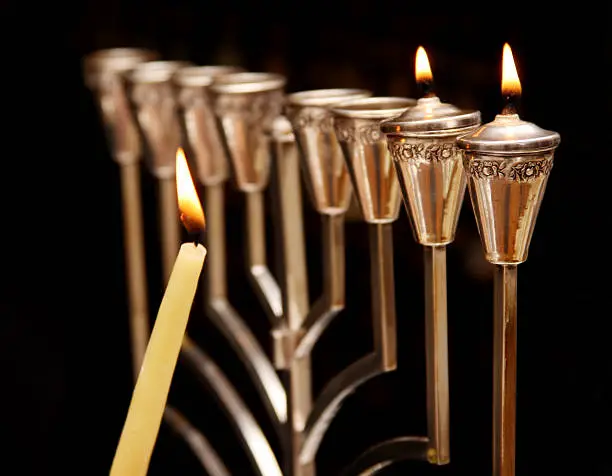BS”D
I’ve mentioned here before that the main miracle of Chanukah was not the improbable victory over the Greeks, nor the discovery of the one flask of pure olive oil, nor even the fact that the light of the menorah lasted eight days. The biggest miracle was that the Chashmonaim choose to step up to a battle that seemed lost before it began and to serve Hashem with everything they had– even if that everything was inadequate.
So great was the light created by their desire to serve Hashem and their emuna and trust in Him “in those days,” that we can still tap into that very same light “at this time.”1
And, this light can change us. The act of lighting the menorah and looking at its light has the power to strengthen our emuna and bitachon, that is, our connection to Hashem, Torah, and Clal Yisroel.
But, there is another dimension to lighting the menorah that is not so well known.2
Awakening the “Pintele Yid,” the Jewish Spark
Within every Jew Hashem put a spark of kedusha that can never, ever be extinguished. It doesn’t matter how far a Jew is from G-d and mitzvos or the great light of his or her own soul, this pintele yid cannot be touched. It retains its purity at all times:
“My G-d, the neshema that You gave me is pure…”3
This internal spark can also be awakened and ignited and turned into a flame.
When we light the menorah with intent, we light up our souls, and with it, open the door to teshuva. But, we can also help to ignite the Pintele Yid of other Jews who are sitting in darkness– those who are disconnected, confused and blind to their own spiritual potential and the Creator Who has given it to them. As a result they too can ultimately be inspired to return G-d and their unique spiritual tafkid (role) in the world.
Why the Yeshua of Chanukah Came from the Kohanim
In the days of the second Bais HaMikdash, Greek influence and eventually oppression enveloped the Jewish people within a heavy spiritual darkness. Many Jews of the time eventually rejected their spiritual birth rite, in favor of a modern lifestyle that offered unbridled hedonistic pleasures.
Ultimately, it was the actions of the Kohanim that saved them.
When the first and second Beis HaMikdash stood, the Kohen Gadol, supported by a rotating team of Kohanim were responsible for doing the holy avoda within “Hashem’s House.” This service primarily involved preparing and offering up the daily and Yom Tov korbonos (sacrificial offerings).
The role of the Kohen Gadol was additionally to supervise the service and act as a spiritual leader to the Jewish people. It was he who lit the menorah and conducted the awe-inspiring service of Yom Kippur, during which he entered into the Kadosh Kadoshim (Holy of Holies) with an incense offering. The Kohen Gadol was to act as an advocate for the Jewish People and thus arouse Divine mercy on one hand, while simultaneously awakening the Jewish people to teshuva on the other.
Through his actions in the Bais HaMikdash and his prayers on behalf of the Jewish people, the Kohen Gadol in particular could light the internal sparks of kadusha that rested within Jewish hearts till they became a flame of teshuva.
Invested with this power, Matisyahu, the Kohen Gadol of the time, together with his sons, organized a rebellion against the Greeks and their culture. After their subsequent victory, the Chashmonaim made an impassioned return to the Beis HaMikdash– which culminated in miracle of the small pure flask of oil and the eight-day light of the menorah. After news of these events had spread, the Jewish people engaged in a communal re-dedication of themselves to Hashem and His Torah. This is alluded to in the word “Chanukah” which means “dedication.”
The intense emuna, bitachon and yearning for Hashem on behalf of Matisyahu and the priestly Chashmonaim family, lit up the Jewish people, leaving flames of teshuva in its wake– a spiritual effect that returns to the world every year at this time.
Additionally, the olive oil alludes to the spark of kedusha within every Jew. Only a flask with the unopened seal of the Kohen Gadol could be used to light the menorah. This is a further hint to the fact that the Kohen Gadol could fan flames of teshuva within the Jewish People– even those who are far away.
Who Can Light Up Sparks of Kedusha Today?
Today, however, when there is no Beis HaMikdash, we take the place of the Kohen Gadol. In the Al HaNissim prayer, it says “…and [the Kohanim] lit candles in the courtyards of Your sanctuary.” Court yards are on the outside. This is a hint to the fact that when we light the menorah, we can also light the sparks of kedusha within those who stand “on the outside,” far from Yiddishkeit and far from the great light hidden within them.
For this reason Chanukah is a time for Hallel and Hodo’ah (gratitude). We say Hallel, praises of Hashem, for the Divine internal sparks of kedusha that are invested in us, and express our gratitude for the fact that those sparks can be woken up and turned into a flame of teshuva for those both near and far.
On Chanukah, may we be lit up by the hidden light of the menorah and be inspired to return even as we inspire others.
- The words of the Al HaNissim Prayer
- The following is based on a dvar Torah by the Belzer Rebbe on the fifth night of Chanukah 2021.
- From morning prayers


